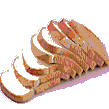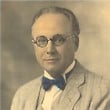| Invention: | bread slicer in 1928 | | | Definition: | noun / bread slicer | | Function: | To cut or divide a loaf of bread into slices.The world’s first mechanical sliced bread went on sale July 7, 1928. | | Patent: | 1,867,377 (US) issued July 12, 1932 |
| | Inventor: | Otto Frederick Rohwedder | | | Criteria; | First practical. Entrepreneur. | | Birth: | July. 7, 1880 in Des Moines, Iowa | | Death: | November 8, 1960 in Concord, Michigan | | Nationality: | American |
| Milestones:
1912 Otto Rohwedder toys with the idea of producing a machine to slice bread
1916 Rohwedder begins to design a machine to slice bread
1917 fire destroys his factory, prototype machine and the blueprints
1926 Toastmaster begins selling pop-up toasters
1927 Rohwedder finally saves enough money to begin again to build a bread slicer
1928 Rohwedder files patent application for a single step bread slicing machine
1928 forms a company Mac-Roh Sales & Manufacturing to build and sell the bread slicer machine
1928 first mechanical pre-sliced bread goes on sale to the public in Chillicothe, Missouri
1929 St. Louis, Missouri baker, Gustav Papendick, adds improvements to Rohwedder’s machine.
1930 Wonder Bread begins selling pre-sliced bread, most bakeries follow suit
1932 toaster sales skyrocketed, thanks to the standardized size of sliced bread
1933 American bakeries were turning out more sliced than unsliced bread
1933 Rohwedder sells patent rights to and goes to work for Micro-Westco, Inc.
1934 Patent 1,970,379 issued August 14, 1934 for Slicing Machine assigned to Papendick, Inc.
sliced bread, bread slicer, bread slicing and wrapping machine, toaster, Otto Rohwedder, Gustav Papendick, M. Frank Bench, wonder bread, invention, history, inventor of, history of, who invented, invention of, fascinating facts. |
|
The Story:
Bread is one of the oldest prepared foods, dating back to the Neolithic era when cereal grains and water were mixed into a paste and cooked. In ancient Egypt bread-making became one of the most significant areas of food preparation, along with the making of beer; both had religious significance as well. It is thought that the Egyptians invented the first closed oven for use in baking. Bread was a primary staple of diet in much of European history, from at least 1000 BC into modern times.In the 19th century people either made their own bread at home or purchased bread at the local bakery sold in loaves. But Otto Frederick Rohwedder, an inventor changed the history by creating the presliced-loaf and sealed-bag process. Without Otto Frederick Rohwedder, no one could exclaim: “It’s the greatest thing since sliced bread!” Rohwedder was born Des Moines, Iowa and grew up in Davenport, Iowa. He married Carrie Johnson in 1905, and the couple had two children. Rohwedder was a jeweler by profession, and owned three jewelry stores in St. Joseph, Missouri. Beginning in 1912 while living in St. Joseph, Missouri Otto toyed with an idea for a bread slicing machine that would revolutionize the baking business. Convinced that such an invention would work, he sold his jewelry stores and used the funds to finance his new venture.He returned to Davenport at the end of 1916 and spent several months working on a prototype which included the sliced bread being held together by metal pins and was unsuccessful.. His first venture ended in tragedy in November 1917 when fire destroyed a Monmouth, Ill., factory that was to have produced the first slicing machine. Rohwedder’s blueprints and prototype were also destroyed. It took Rohwedder several years to recoup his losses and assemble investors and financing for another go-at-it. In the meantime, he worked as an investment and security agent during the 1920s. In 1927 he designed a machine that not only sliced the bread but also wrapped it. His new and improved commercial bread slicer, was completed in 1928. Rohwedder’ filed his application for a patent on November 26, 1928 and formed a company Mac-Roh Sales & Manufacturing to build and sell the bread slicer machine. There were objections from skeptic bakers that pre-sliced bread would quickly dry out. Despite this, Rohwedder took his slicer to the Chillicothe Baking Company in Chillicothe, Missouri where he convinced a baker friend and owner of the company, M. Frank Bench, to use it. History was made on July 7, 1928, when bread was sliced and wrapped commercially for the first time by a bread slicing machine. For the record, the brand name was Sliced Kleen Maid Bread. Customers marveled at the evenly sliced pieces, which were handy for making sandwiches and toast. A baker in St. Louis, Missouri Gustav Papendick, bought the second slicer produced by Rohwedder. He improved the cutting action, but found bakers objected to sliced bread: They felt the loaf would dry out too quickly. So, Papendick set out to invent a machine that would wrap the bread, and keep it fresh. To do this he needed to keep the sliced bread together long enough so his machine could wrap it. He first tried rubber bands and then metal pins to keep the loaves intact, but both failed. Finally a simple idea hit him: Put the bread in a collapsible cardboard tray, which would precisely align the slices so a machine could wrap them. His sliced bread made sales in St. Louis jump by a whopping 80%. The Continental Baking Company altered the course of bread forever in 1930 when it introduced sliced Wonder Bread. Sales were slow at first as suspicious consumers were slow to accept a pre-sliced bread, but convenience overruled apprehension and soon everyone wanted sliced Wonder Bread on their dinner table. This gave a boost to another new invention: Charles Strite’s spring-loaded, automatic, pop-up toaster which had been languishing on the shelves since 1926. With Rohwedder’s standardized slices on the market, Strite’s invention suddenly made sense. By 1933, only five years after its introduction, American bakeries were turning out more sliced than unsliced bread. Rohwedder sold his invention to the Micro-Westco Co. of Bettendorf, Iowa, and he became vice-president and sales manager of the Rohwedder Bakery Machine Division of Micro-Westco, Inc. Rohwedder retired to Albion, Michigan in 1951 with his wife Carrie, where their daughter Margaret Steinhauer, and his sister Elizabeth (Rohwedder) Pickerill lived. Without Otto Frederick Rohwedder, no one could exclaim: “It’s the greatest thing since sliced bread!” Rohwedder invented the first machine to slice bread. But was sliced bread really such a great thing? Yes! Sliced bread was the culmination of a century of technological innovation. It needed electricity, a uniform sized loaf of bread, a plastic wrap and a toaster to build up the demand. Rohwedder Bread Slicer Patents (1927-1936): - U.S. Patent 1867377 — Bread slicer
- U.S. Patent 1867378 — Bread feeding appliance
- U.S. Patent 1740038 — Bread slicer wire
- U.S. Patent 1591357 — Bread rack
- U.S. Patent 1724368 — Bread staples
- U.S. Patent 1759592 — Bread staples
- U.S. Patent 1935996 — Bread handler
- U.S. Patent 2034250 — Bread handler
- U.S. Patent 2061315 — Bread handler
Note:
Half the resources say sliced bread was introduced in Battle Creek, Michigan the other half say it was in Chillicothe, Missouri. The Missouri story has the more robust documentation. |

